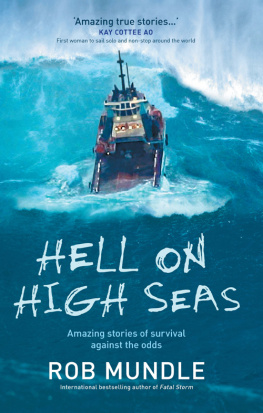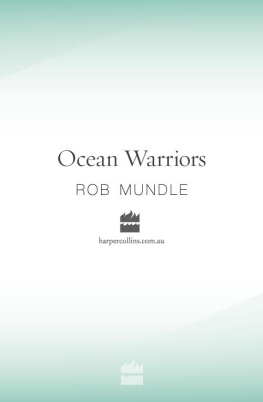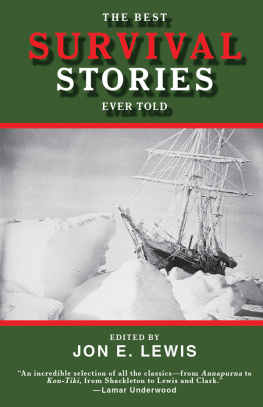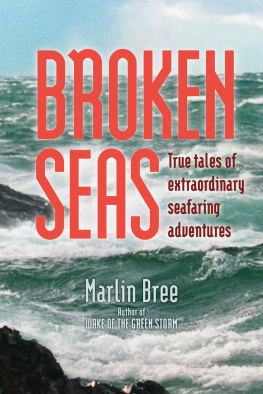To those who run with the spirit of adventure, and those who wish they could.
I t struck with the speed of a viper: the heavy wire locked instantly onto my legs with horrendous tension and the whiplash effect that came from above was so violent that my head didnt hit the deck; I went from being upright to upside down in a blur.
Suddenly my body was hurtling unimpeded through the bitumen-black night sky, and right then just one thought went spearing through my mind: This is how you are going to dieyoure dead! I was a human rocket that had been launched across a rough and despicably uninviting sea, and I was certain there was no coming back.
The only ineffaceable memory from the ensuing 30-plus seconds is the brief glimpse I caught of the deck of the yacht which was illuminated by lights mounted on the mast. I was then in mid-air and upside down, and the yacht was a terrifying distance below me. I was being flung around like a stuffed toy in the mouth of an over-zealous dog a dog that was actually an enormous 460 square metre (5000 sq ft) wildly flogging spinnaker that was set from the top of a mast 30 metres high. It was during one of those flogs that the wire ripped free from my legs, but I was still attached to the sail by what was my one chance for survival a death grip: my lifeline. My fists were locked vice-like onto a rope, the sheet, which was attached to the corner of the sail, and I wasnt letting go.
The scene came at 10 pm on a wildly windy night when we were 20 miles off Cabo Maisi, the easternmost point of Cuba in the region known as the Windward Passage. The year was 1971 and I was aboard one of the great racing maxi-yachts of the era, American Huey Longs Ondine II. We were destined for Montego Bay, Jamaica, and the finish of the 811 mile race that had started in Miami some 48 hours earlier.
Ondine II boasted an impressive list of successes in many of the worlds great ocean races, including line honours in the 1968 Sydney to Hobart classic and twice in the Newport to Bermuda race, but great as she was, this 79 foot aluminium-hulled ketch that weighed in at 50 tonnes was actually a pig of a boat when racing under spinnaker in strong winds, and thats what wed been doing most of the time since we left Florida. She had a mind of her own when she surfed the big waves that had been generated by the 25 knot tropical tradewind. Each time she bullocked her way down the face of a wave even the most seasoned helmsmen struggled to retain control there was no way of guessing which way she would veer off course, port or starboard, when she buried her bow into the back of the wave ahead. It was during one of those unpredictable veers when the entire rig went under massive load that the heavy wire restraining the spinnaker pole couldnt cope. It literally exploded. BANG! And with that the sail became a raging bull.
I was a fit 25-year-old back then, and for this race Id been drafted as one of the foredeck crew; a member of the young team that did the hard yards, setting the huge, heavy and cumbersome 150kg headsails and the spinnakers.
The call for all hands when the wire broke had those of us on the off-watch scurrying up the companionway stairs and onto the deck to discover what was causing the yacht to shudder so violently, and what needed to be done to stop it. The spinnaker pole was smashing against the forestay at the bow each time the gyrating sail thrashed around in the powerful wind, and it needed to be restrained.
The deck lights had been switched on and I could see a cluster of crew on the leeward side of the mast hauling on a rope and wire. They were trying to bring the corner of the sail down to the deck so they could unclip the spare wire attached to it. The obvious plan was to take that wire to the windward side of the yacht, attach it to the spinnaker pole and then winch the pole and sail back into position so we could resume racing mode.
I scampered forward in bare feet to lend a hand, and as I neared the scrum I realised that if I hoisted myself high on one guys shoulders I could reach the elusive clip, snap it open and free the wire from the corner of the sail.
Great idea bad timing!
I leapt up towards my target with all the right intentions, but as I did the yacht rolled to windward and the spinnaker filled with wind as if it had been hit by a jet blast. There was no stopping the spinnaker it burst open as if someone had pulled the ripcord on a parachute and there was no stopping me going with it!
The power then in the sail was grossly greater than the strength of the manpower trying to haul it to the deck, so my crewmates, quite sensibly, let go. Id assumed someone had been taking up the slack on the loose wire so the sail could be contained should a situation like this eventuate. I was horribly wrong.
As the sail exploded skywards the spaghetti-like coil of slack wire that was on the deck somehow snapped around my legs like a giant bear trap: this was bungy jumping with no bungy. I was convinced I was on a one-way trip through the air and into the water, and once I hit the waterwell, I may as well have been going through the trapdoor of the gallows. It would have taken a saint-making miracle for the crew to get the yacht back under full control, turn her around then retrace a course of around five miles through the darkness to where I had become man overboard. There was no chance theyd find me alive.
Its because of another miracle that I sit here today writing Hell on High Seas: the death grip! It was something Id heard about but never believed possible.
Somehow during those first few seconds of my eviction from Ondine IIs foredeck I managed to get both my hands on the spinnaker sheet the rope attached to the corner of the sail that is used to control its shape when set. The split second I realised that I was in life-threatening trouble my mind sent an urgent message to my hands: If you let go of that rope then we are off to meet our maker.
That certainly wasnt my preferred option, so this man on a rope locked on for dear life.
There was one other thing in my favour the calibre of the crew, especially an offshore yachting legend, the late Cy Gillette from Hawaii, who was on the helm at the time, and Sam Field, who had been with me on the foredeck. On realising that I was still hanging on to the sail, Cy knew the only thing to do was to immediately, and dramatically, change the yachts course to leeward so that the spinnaker would collapse in the wind shadow created by the mainsail. If the move was successful then I would crash to the deck like a bird without wings safe, but a bit knocked around. That was the only hope, and Cys execution of the manoeuvre was near perfect. However, instead of crash-landing on the deck, my downward trajectory had me missing by a metre or so just outside the yacht and heading for the water and my chances of hanging on to the rope once I was being dragged along in the water at around 15 knots were three-eighths of stuff-all.
Incredibly, Sam saw me descending from the heavens and had the foresight to run to the side of the yacht, grab hold of the mast sidestay, lean out over the water and somehow, miraculously, get a hand on me. His actions were enough to slow my descent and allow other crewmates to grab hold of various parts of me arms, legs and clothing and hang on to me. I was conscious of them screaming at me to let go of the spinnaker sheet, that they had hold of me, and I was aware that they were trying to force my fingers to unlock my grip on the sheet, but my mind wasnt sending the release message to my hands; the adrenalin pump that had brought about the death grip still wasnt convinced I was safe. The crew feared that the sail would fill with wind and again take me with it, and thats where their enthusiasm to get me onto the deck solved the problem. They dragged me aboard feet first with one leg either side of the 10cm diameter steel roller fitted around the sidestay. The crushing impact on my credentials brought an immediate result my eyes watered, I felt excruciating pain, I got lumps under my ears and I let go of the rope!











